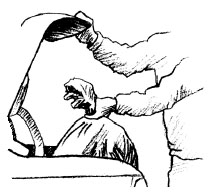Save Your Skin  |

|
| Not so fast! Did you clean your hands first? |   |
| Your hands might be contaminated. |  |
| Putting gloves on over these contaminants traps them against your skin. |  |
| That can lead to irritation and dermatitis. |  |
| Always
wash with a pH-neutral or slightly acidic soap or cleaner. Ask your pharmacist to recommend one. At work, a buffering or neutralizing spray may reduce surface skin pH. |
 |
| Avoid
sensitizers, like lanolin and limonene. If you must use lanolin or limonene, apply it at home after you have thoroughly cleaned your skin. |
 |
| If
you can’t leave your work clothes at work, take them home in
a separate container. Trash bag work great! |
 |
| Wash your work clothes separately to protect your family. |  |
| Clean
reusable gloves daily. Follow the manufacturer’s instructions. Store them away from tools and materials in a cool, dark, dry place. |
 |
| To
remove disposable gloves, peel back from the top, turning them
inside out. Discard them at the jobsite each day. |
 |
| Don’t wear watches, rings or other jewelry while you work. |  |
|
So, wash your hands first. Use a pH-neutral or slightly acidic soap. Clean the nail beds, too. |
 |
| Dry your hands thoroughly with a clean towel or wipe. |  |
| While you’re at it, why not wear a light-weight cotton glove liner to keep your hands dry and comfortable. |  |
| If
you remove your gloves during work, wash again with clean water and
soap, or you may carry contaminants into your gloves. If you have no clean water, try carrying a clean damp wash cloth or disposable towelettes. |
 |
| Before
removing your gloves, always clean off the outsides. Follow the manufacturer’s instructions. |
 |
| To remove gloves, loosen them on both hands. Hold hands down so contaminated water will not drip onto skin or clothing. |  |
|
Keeping gloves down, remove the first glove only to the fingers. The cuff of the glove will remain over your palm. |
 |
| Now, grabbing the second glove with the first glove, remove the second glove. |  |
| The
first glove should slip off. Try to handle gloves by the insides only. Don’t touch the outsides. |
 |
| If you get a persistent skin problem, even a minor one, see a physician. Be sure to tell your doctor that you work with wet portland cement. |  |
Remember, your hands are your living. Protect them. They will last your lifetime. |
 |
![]()
.
This
paper appears in the eLCOSH website with the permission of the author
and/or copyright holder and may not be reproduced without their consent.
eLCOSH is an information clearinghouse. eLCOSH and its sponsors are not
responsible for the accuracy of information provided on this web site,
nor for its use or misuse.
© Copyright 2000 CPWR – Center for Construction Research and Training. All
rights reserved. CPWR – Center for Construction Research and Training is a research
arm of the Building and Construction Trades Dept., AFL-CIO: CPWR, 8484
Georgia Ave, Suite 1000, Silver Spring, MD 20910. (Edward C. Sullivan
is president of the Building and Construction Trades Department and CPWR.)
Production of this pamphlet was supported by a grant from the National
Institute for Occupational Safety and Health (NIOSH). The con-tents are
solely the responsibility of the authors and do not necessarily represent
the official views of NIOSH. Written, developed, and produced for CPWR
by FOF Communications.
![]() eLCOSH
| CDC | NIOSH
| Site Map | Search
| Links | Help
| Contact Us | Privacy Policy
eLCOSH
| CDC | NIOSH
| Site Map | Search
| Links | Help
| Contact Us | Privacy Policy
